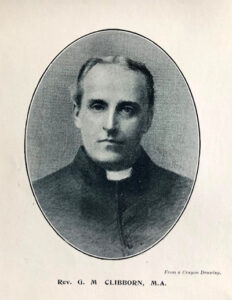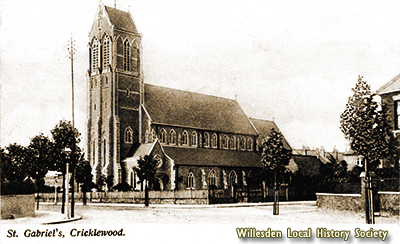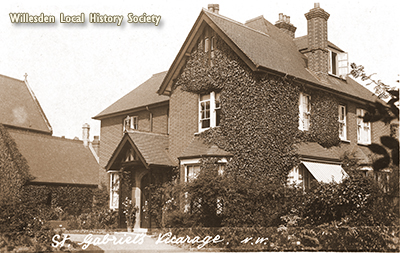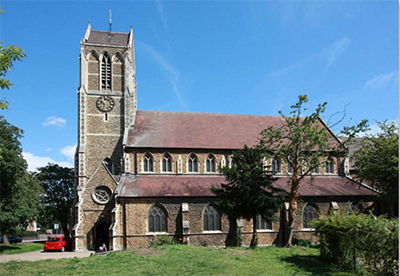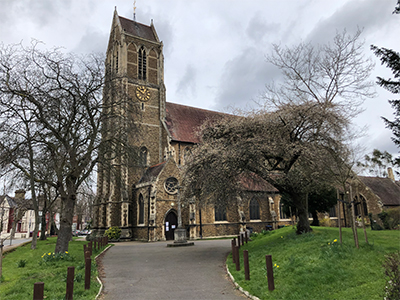
St. Gabriel’s Church
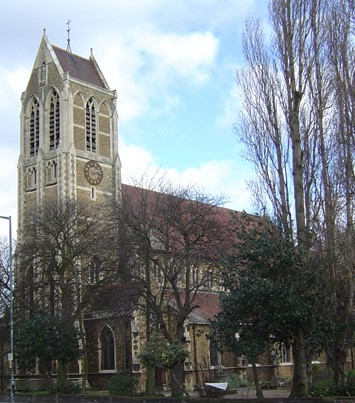
The History of St.Gabriel’s Church
This Grade II listed church was consecrated in 1897 and the story of its origins are intertwined with the life story of the first vicar the Reverend George Marsh Clibborn. He was born in 1857 in Dublin and served as a curate in Old Street in the City of London for 10 years. Then he was appointed in 1891 as a “Diocesan Home Missionary” to tend to the people in the “country” between Edgware Road (now known as Cricklewood Broadway and Shoot-Up Hill) and the Metropolitan railway.
Initially he had 500 people scattered around in his parish and had to borrow accommodation in a milliner’s shop for his first service. Then he was lent the use of a schoolroom for services. After some fund raising, he organised the building of an Iron Church in 1891 on the site of the present church hall at the junction of Anson Road and Chichele Road. This land was bought from All Souls College, Oxford, who were big land owners in the area.
The iron church could accommodate 300 people, but soon there was not enough space. Also the church was either very hot or very cold! So another fund raising drive was started to build a new church. The land was given by the Ecclesiastical Commissioners and plans were drawn up. The foundation stone was laid in 1896 and the new St Gabriel’s church was consecrated in 1897.
The Iron Church was converted to a church hall around the same time.
Rev. Clibborn contributed the considerable income from pew rents, to which he himself was entitled, to the building fund. These pew rents were socially divisive and were a cause of controversy as it was considered that the practice alienated the poorer classes. Everyone was happy that this income facilitated the completion of the work.
When the church was consecrated the Chancel, the Lady Chapel and the first 3 arches of the nave were complete. At the time Rev. Clibborn was living in St. Gabriel’s Lodge, Grosvenor Gardens, but a splendid vicarage was being built next to the church and this was blessed in June 1900. Shortly after, the vicar went to Cornwall for a holiday but while he was away disaster struck. On a very hot July day the church was hit by lightning, burning the roof of the nave.
Rev. Clibborn came back from Cornwall and set about repairing his damaged church. The congregation moved back to the hall of the iron church, there while St Gabriel’s was being repaired and the building completed. In 1903 the building as you see it today was finished. The total building costs were shown in the 1906 accounts to be £16,980.
The Architectural Heritage of Brent Archives 1984 describes the building as follows: “a brick church with limestone dressings comprising chancel, nave with clerestory and low side aisles. The conspicuous sloping tiled saddleback tower is a local landmark”.
The tower was designed by Rev. CFG Turner and replaced a planned steeple due to the fact that the local clay soil could not support it.
The narrow pillar supporting the tower is based on a similar one on Ely Cathedral.
Heating the church was a challenge, with the original system being replaced after only five years.
From the early days, the church supported missionary work, and in 1896 the Sunday School sponsored a schoolboy from Zanzibar.
From the 1890’s, St Gabriel’s held “lantern lectures” : informative talks illustrated with coloured slides.
In 1912 the parishioners collected money to celebrate the 21st anniversary of Rev. Clibborn’s ordination. Approximately 700 people contributed £240. He was presented with a gold watch and his wife was given a diamond and pearl pendant. The balance of £140 was transferred to him and he planned to use it to travel to Russia with a friend, the Rev. Osborne, to study the Russian Orthodox Church at first hand.
Later that year tragedy struck Rev. Clibborn in Sweden. He and Rev.Osborne were on an overnight journey from Malmo to Stockholm when their train was struck by a goods train due to a signalling mistake. Rev. Clibborn was killed and his friend badly injured. His body was brought back to St Gabriel’s and his remains were buried outside on the south-east corner at the junction of the south wall and the vestry. The Queen of Sweden sent a letter of condolence.
Following his death, the east window over the main altar showing four archangels and the carved rood screens were commissioned in his memory, as well as a carved triptych. These were all designed by John Coates Carter, known for his Arts&Crafts style. He also later designed the war memorial that still stands in the church driveway and the parclose screen inside the church.
Most of the stained glass windows were made by James Powell & Sons, who also made windows for St Paul’s Cathedral.
The church bells, installed in 1919, came from the Whitechapel bell foundry that also made Big Ben and the Liberty Bell. The clock was made by Gillet & Johnston.
St Gabriel’s supported refugees from various war torn countries during World War I. The many commemorative plaques in the church record soldiers killed in the war, mainly young officers, as this was a “yuppie” area in those days. An extremely sad plaque is that commemorating 2nd Lieutenant Powell, who had been superintendent of the Sunday School. The first telegram from the war office said he had been killed in action. The second telegram said he was not dead but had been wounded in action. The third telegram said that he had in fact been killed.
The church suffered minor bomb damage during World War II and the clock on the tower suffered from vibrations caused by heavy gun fire in the area.
Evacuations dramatically reduced the size of the congregation, and following the war the local community was in transition, with immigrants of many other faiths moving into the area. Despite this, the heating system and the church organ were significantly upgraded.
During the 1950’s the church benefitted from the organ and building being used for BBC concerts and recordings.
Successive vicars served long appointments: Rev. Gill 26 years, Rev. Bulman 33 years and Reverends Hilburn, Gower and Lambert five years each, some of whom were temporary priests-in-charge, as there was often uncertainty regarding whether keeping the church open was viable. Nevertheless repairs were maintained and the missionary work continued.
In 1994 Rev. Aldridge took up the baton and started running Alpha courses which boosted the congregation. He was in the post for ten years, before Rev. Jane Morris took over in 2005.
More recent changes include the rebuilt weather vane and the re-gilded clock faces on the tower. The organ has been relocated elsewhere. There was a period in the past when the clock was renowned for its failure to tell the right time, but has worked perfectly since 2017, when a new mechanism was installed. The church bells can be regularly heard.
At the time of writing the incumbent vicar is James Yeates, who took over from Rev. Morris in 2020.
Credit for most of the above information goes to Jim Allen and Susan Blake who each published histories of the church.
Anne Aiken and Hester Coley – March 2021
